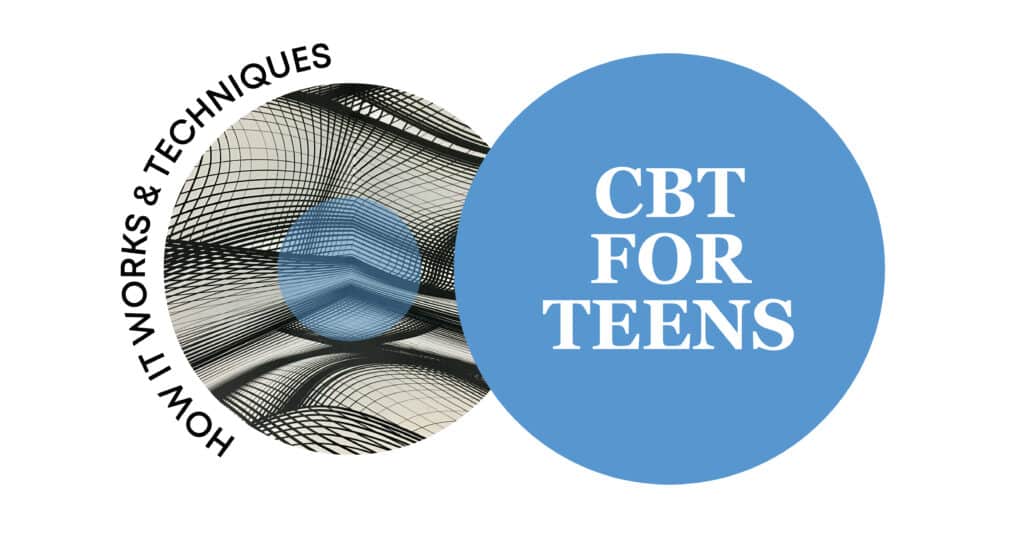Cognitive Behavioral Therapy for Teens – Benefits & Tips
Mental disorders happen to be among the fastest-growing concerns for teenagers these days, as they face an immense load of burdens having to do with school pressure, peer pressure, and self-imposed limitations. Cognitive Behavioral Therapy (CBT) for teens is one of the most successful treatments for such problems in this age group.
Here, we will illuminate different aspects of CBT techniques for adolescents, including their work, the benefits, the most frequent complaints it addresses, and much more. If you’re interested in any information regarding guidance to bring about intervention in adolescent mental health or assistance to adolescent mental health in any way, then learn how lasting solutions can be achieved through CBT.
What Is CBT?
Cognitive Behavioral Therapy is a very time-limited and structured psychotherapy that assists in understanding and changing a person’s distorted thinking patterns, emotional responses, and behaviors. The treatment goal is oriented toward current problems rather than a past-the-road exploration into individual developmental history. CBT is especially effective for all age groups in helping deal with realistic issues by providing concrete tools for doing so day-to-day.
Essentially, CBT for adolescents includes content relevant to teaching them how their thoughts affect their feelings and behaviors. Once identified, the negative thought patterns can be replaced with more constructive ways of thinking, leading to good emotional regulation, problem-solving, and self-confidence.
Dr. Aaron T. Beck pioneered the concept in the 1960s. The original intent of CBT with respect to adolescents has changed significantly with time, as the application of Cognitive Behavioral Therapy for teens has grown to treat adolescent mental health problems. Today, it is most commonly applied to a variety of issues faced by adolescents, including anxiety disorders, mood disorders, and various types of behavioral problems.
Hillside Horizon
How Does CBT for Teens Work?
CBT for teens needs to connect their thoughts and feelings with behaviors. It teaches healthy ways of thinking to adolescents along with negative emotions such as anxiety, sadness, and anger. CBT for adolescents aims to establish a healthful response to everyday challenges by targeting unhealthy thoughts.
Identifying Negative Thoughts |
The first step in CBT usually involves getting teenagers aware of their particular thought processes. The teenagers become familiarized with negative automatic thoughts and thoughts that come spontaneously and usually make them feel miserable or emotionally uncomfortable. |
Challenging and Reframing Thoughts |
Once negative thoughts are recognized, adolescents begin to work with the therapist to challenge them. They may ask themselves, “Is this true thought?” or “What evidence do I have to support or oppose it?” So, teens learn to redefine distorted thinking toward more balanced and rational analysis. |
Behavioral Change |
The next step after cognitive restructuring is behavior change. Teenagers must involve themselves in participating in activities they have thought to have confirmed with their new thinking. For example, a socially anxious teenager might start gradually exposing himself or herself to social situations with the support of his or her therapist to build confidence. |
CBT isn’t just talking with teens, it’s practical stuff, such as journaling, goal setting, and behavior practice. It’s the best active therapy that teenagers find appealing.
How Effective Is CBT for Teens?
Its usefulness for youth has been validated by several trials and studies done to try it out across different clinics. The use of CBT approaches in teen clients is a proven therapy for several mental health problems, such as depression therapy in teenagers, therapy for teenage anxiety, and behavioral issues.
CBT brought teenagers to such significant reductions in depression and anxiety symptoms. More than 70% of such anxious adolescents undergoing CBT expressed considerable improvement in their symptoms. Research has similarly shown that the gloomy teenagers in teenage depression therapy were stirred toward better functioning and improved mood.
Mainly because it is highly flexible, CBT can be used to treat almost any mental health condition affecting youth, making science therapy an invaluable capability in their help. CBT is different from medication because, instead of simply masking the symptoms, it teaches these teenagers the ways of coping that they can practice every day. These are also things to help them deal with really tough emotions, build resilience, and manage stressors in healthier ways.
What Are the Benefits of CBT for Teens?
CBT for teens offers numerous benefits, not just in alleviating symptoms of mental health disorders, but also in building lasting life skills. Here are some key benefits of CBT for teens:
- Enhanced Emotional Regulation
Mood disorders mostly bog down those youngsters. CBT for adolescents aims to teach the understanding and control of their emotional reactions. Adolescents are more capable of controlling emotional responses that arise during stress, frustration, and anxiety simply by learning reframing.
- Improved Self-Esteem
Adolescents will learn to challenge their negative self-talk and develop positive, healthy beliefs through various CBT strategies for youth. As they begin to see their thoughts and behaviors change for the better, their self-esteem grows.
- Increased Problem-Solving Skills
Teenagers usually have trouble making decisions, primarily during critical times. CBT for teens tends to break down problems into manageable steps and help them develop strategies for thinking through their decisions.
- Greater Resilience
The most significant benefit of psychotherapy for teenagers is learning resilience. It allows them to bounce back from setbacks while learning how to cope with disappointment and develop healthy frameworks for dealing with challenges.
- Long-Term Effectiveness
Unlike some other therapeutic approaches, CBT is intended to be life-altering. Often, adolescents who go through therapy in group sessions with other teens continue to use the tools learned long after treatment has ended. By giving them essential life skills such as emotional regulation and critical thinking CBT for adolescents cements long-term well-being.
Hillside Horizon
Common Issues Addressed by CBT for Teens
CBT for teens is a highly effective treatment for a variety of common issues faced by adolescents. Let’s break down some of the most common problems that CBT techniques for teenagers address:
Anxiety
Anxiety occurs among the most common mental disorders in teenagers. It may manifest as panic attacks, avoidance behaviors, and even concern. Therapy treatment for teenage anxiety usually focuses on some approaches, such as cognitive restructuring and exposure therapy, for teens to address their fears.
Teens learn how to recognize anxious thoughts and challenge them, causing fewer anxiety symptoms. Gradual exposure to feared situations, such as social events or public speaking, helps them to decrease avoidance and promotes a sense of accomplishment.
Behavioral Issues
Teenagers suffering from behavioral problems such as defiance, impulsivity, and poor impulse control have been known to hinder their academic performance and social relationships.
Teen CBT helps adolescents understand the consequences of their actions and learn how to react appropriately with healthier options during different circumstances. The identified negative behavior triggers are frequently used to stimulate the adolescent to make more positive choices later. CBT techniques for the youth age group consist of role-playing, self-monitoring, and goal-setting.
Depression
Teenagers are more often targeted by depression, and CBT for teens is one of the most efficient treatments available for adolescents suffering from depression. Teenage depression therapies focus on identifying specific negative thought processes that play a role in maintaining depression and replacing them with healthy and more realistic thoughts.
Behavioral activation techniques further engaged students in enjoyable activities, improving their routines. Students’ beliefs about themselves and the world around them were challenged, elevating their mood and improving their perspective.
Stress
Most teenagers are quite likely to experience stress, such as when they face the pressures of their studies. There may also be family issues or something social. CBT for teenagers teaches them tips on managing time using mindfulness and relaxation exercises as real-life practical tools for stress management. Learning how to demonstrate negative thoughts about pressure enables them to learn better ways to cope with stress.
Anger Issues
Teenagers usually find dealing with frustration difficult, which usually complements aggravation from peers, school, or family. CBT assists teenagers in recognizing the signs of anger at their outset and equips them with techniques such as self-soothing, relaxation, and problem-solving.
CBT Techniques and Interventions for Teens
Many CBT techniques for teenagers are powerful enough to affect several mental health challenges. The methods help teens change their thought patterns, regulate their emotions, and foster ways to cope positively.
Cognitive Restructuring
Negative thought patterns are identified and challenged in cognitive restructuring. Teens are taught to assess their beliefs, inquire into their accuracy, and then replace them with an objective perspective. This exercise lessens emotional feelings of anxiety or depression.
Goal Setting
Goal-setting forms an integrated part of CBT for adolescents. By identifying specific, measurable, and attainable goals, adolescents direct their energy toward establishing positive goal outcomes. Goal-setting, therefore, enhances motivation, contributes to boosting self-esteem, and provides the sense of accomplishment necessary for forward movement.
Skills Training
Skills training in CBT focuses on teaching practical skills like problem-solving, emotional regulation, and communication. Teens learn how to manage their emotions and navigate social situations more effectively.
Exposure Therapy
Exposure therapy works well to treat anxiety disorders. It consists of gradually exposing teens to feared situations in a controlled way so they build tolerance and reduce anxiety.
What to Expect During CBT Sessions for Teens?
When adolescents are undergoing CBT, they can expect therapy to be very structured and goal-specific. Most sessions run between 45 and 60 minutes, during which the therapist collaborates with the adolescent to produce a list of the issues, goals, and methods for change.
At the beginning of therapy, the teenagers usually talk to the therapist about what they find challenging. The therapist will help them so that there is a connection between their thoughts and feelings in behavior. They then develop certain things they want to see change through therapy and discuss them using the methods described.
Teens might receive some homework assignments such as journal writing, practicing relaxation techniques, or doing behavioral experiments. These help reinforce what was taught in the sessions while nudging the teenager to take a more active role in their treatment.
Empowering Youth to Overcome Mental Health Challenges
CBT for teenagers is an efficient mode of empowerment that remarkably helps in treating various mental health problems. CBT empowers teens with skills to manage their thoughts, emotions, and behaviors so that they take the benefits far beyond therapy. Whether your teen is using therapy for teenage depression or treatment for anxious teenagers, CBT methods for youth can help your adolescent build resiliency, develop emotional regulation, and thrive.
Call To Action:
Do not hesitate to contact us if you need mental health help for teenagers! Our professional trainers are experts in CBT for teens and are there to guide your teen through his journey toward better mental health. Reach out to us today so we can start discussing adolescent subjects related to CBT sessions and how we can help your teen create a lasting positive change.
Hillside Horizon
FAQs
- What is Cognitive Behavioral Therapy for teens?
CBT for teens is a type of therapy that helps them identify and modify negative thinking patterns and behavior. It is very important in dealing with conditions like anxiety, depression, and behavioral problems, as it equips teens with skills to manage the impact of their emotions and challenge responses.
- How long does CBT take for teens to show results?
CBT sessions for adolescents may require varying lengths of treatment. However, many have noticed improvement after about six or more sessions. Generally, the thoroughness of a teen patient’s commitment, active participation in therapy, and homework assignments define the effectiveness of CBT for that teen.
- Can CBT help with teenage anxiety?
CBT has been most widely used in treating adolescent anxiety. It focuses on teaching adolescents to identify anxious thoughts and replace them with more reasonable ideas. Like other CBT interventions for teenagers, exposure therapy also helps them learn to face their fears gradually with controlled exposure in a safe therapeutic environment where anxiety diminishes slowly.
- How does CBT work for teens?
CBT works wonders for adolescents by helping them regulate their emotions, boost their self-esteem, improve their problem-solving skills, and increase resilience. In addition, it also teaches kids lifetime skills to deal with stress, anxiety, and depression.
- How does CBT work for teenagers with depression?
Cognitive-behavioral therapy for depressed teens identifies and challenges destructive thinking patterns to experience sadness and hopelessness. With cognitive restructuring and behavioral activation, teens’ mood can be altered by acquiring healthier thoughts and activities that enhance happy feelings.





